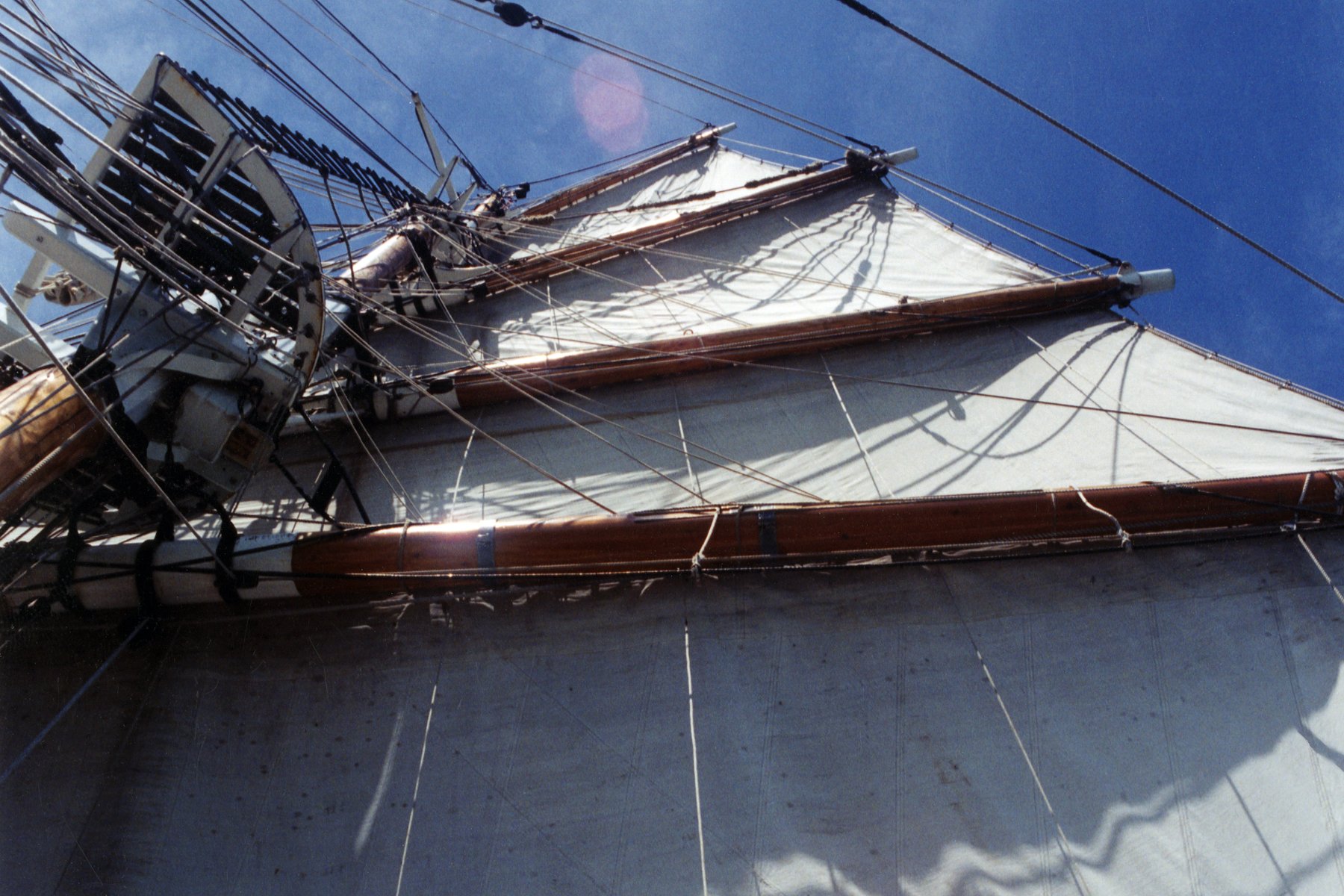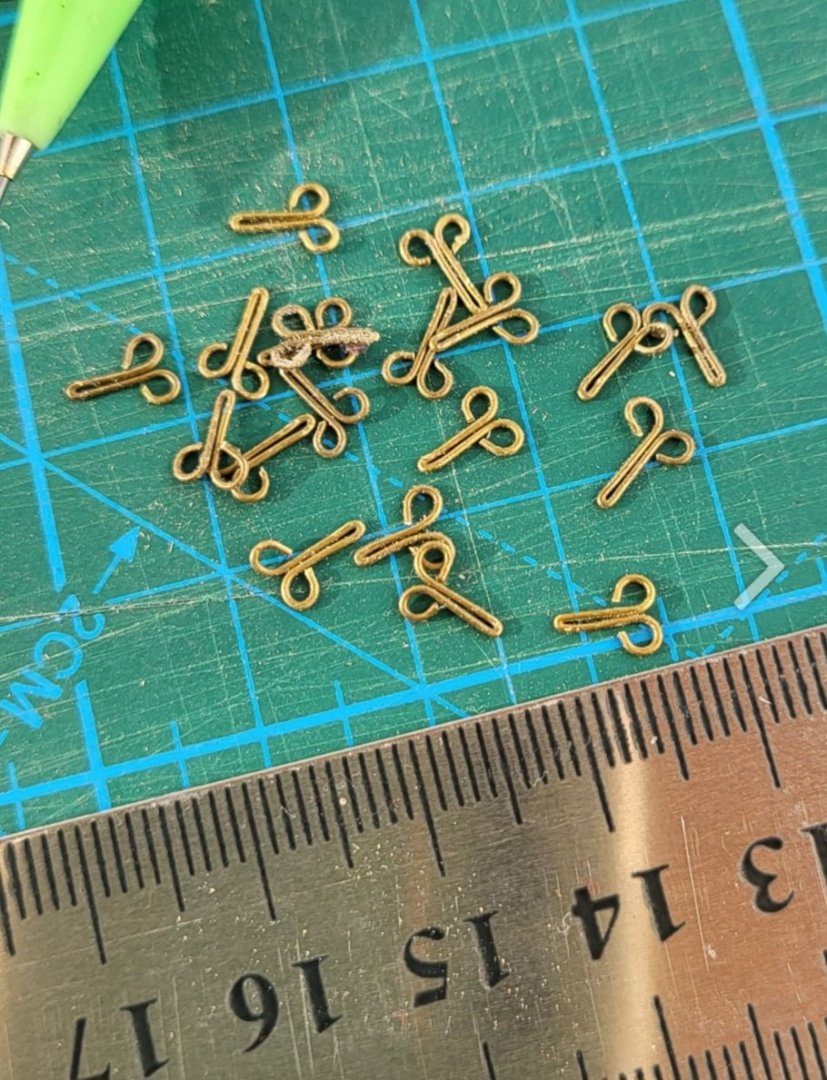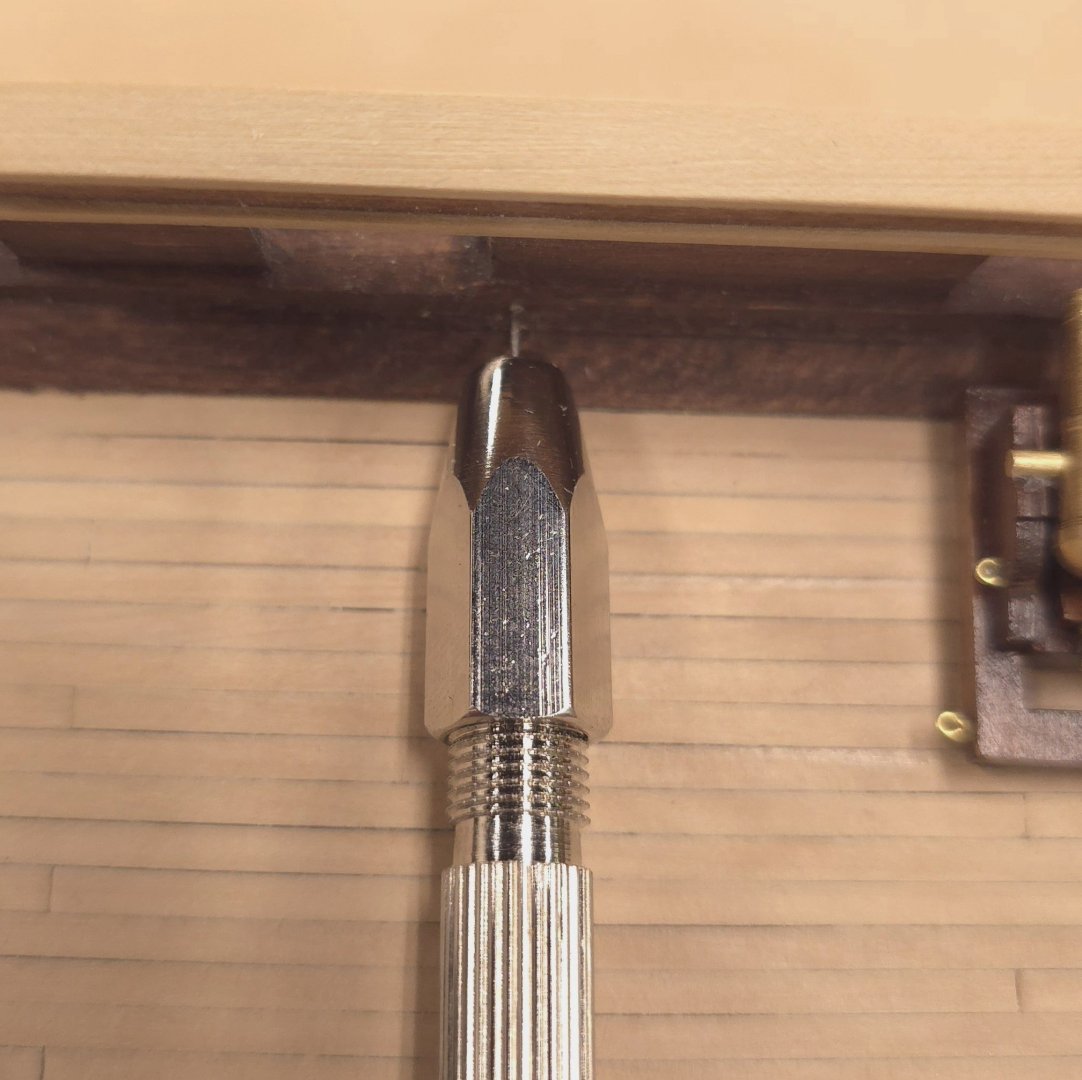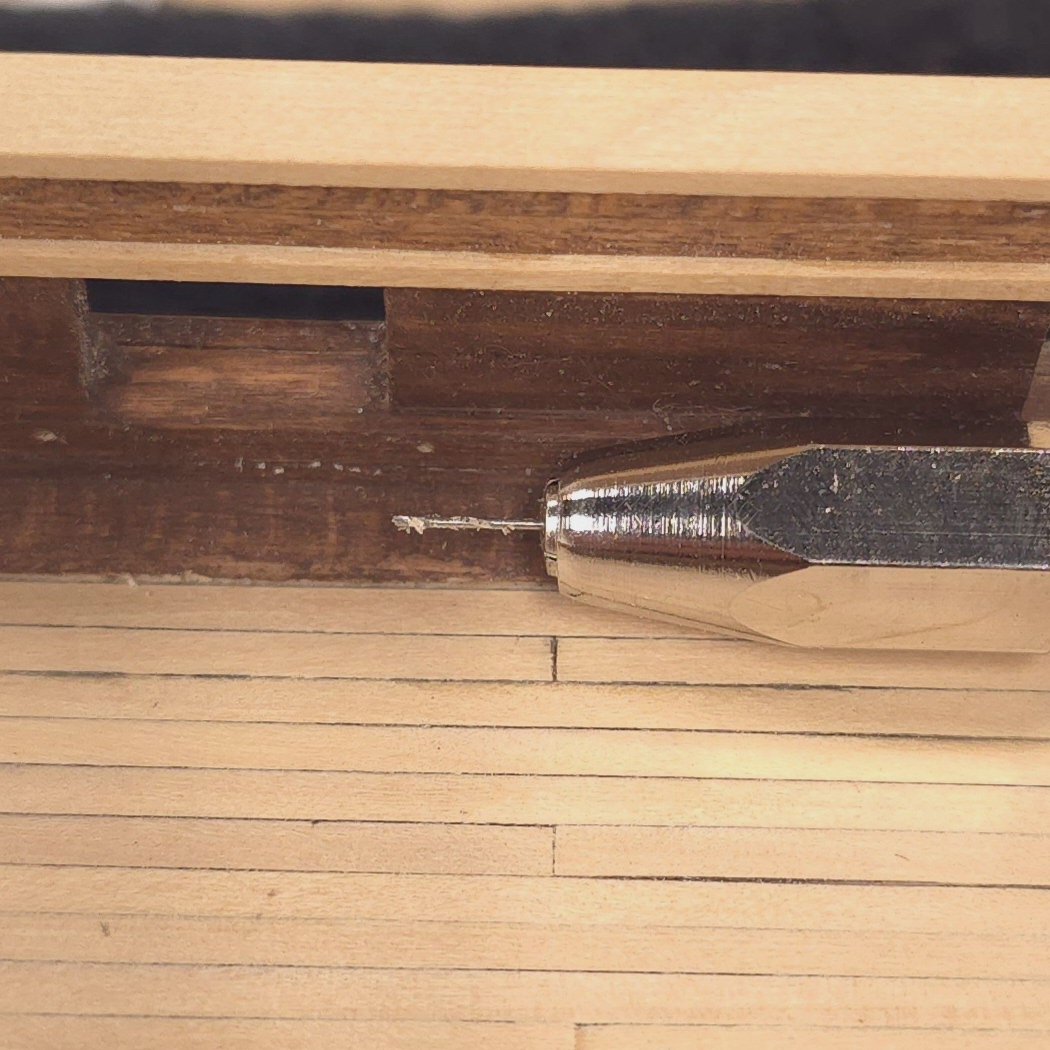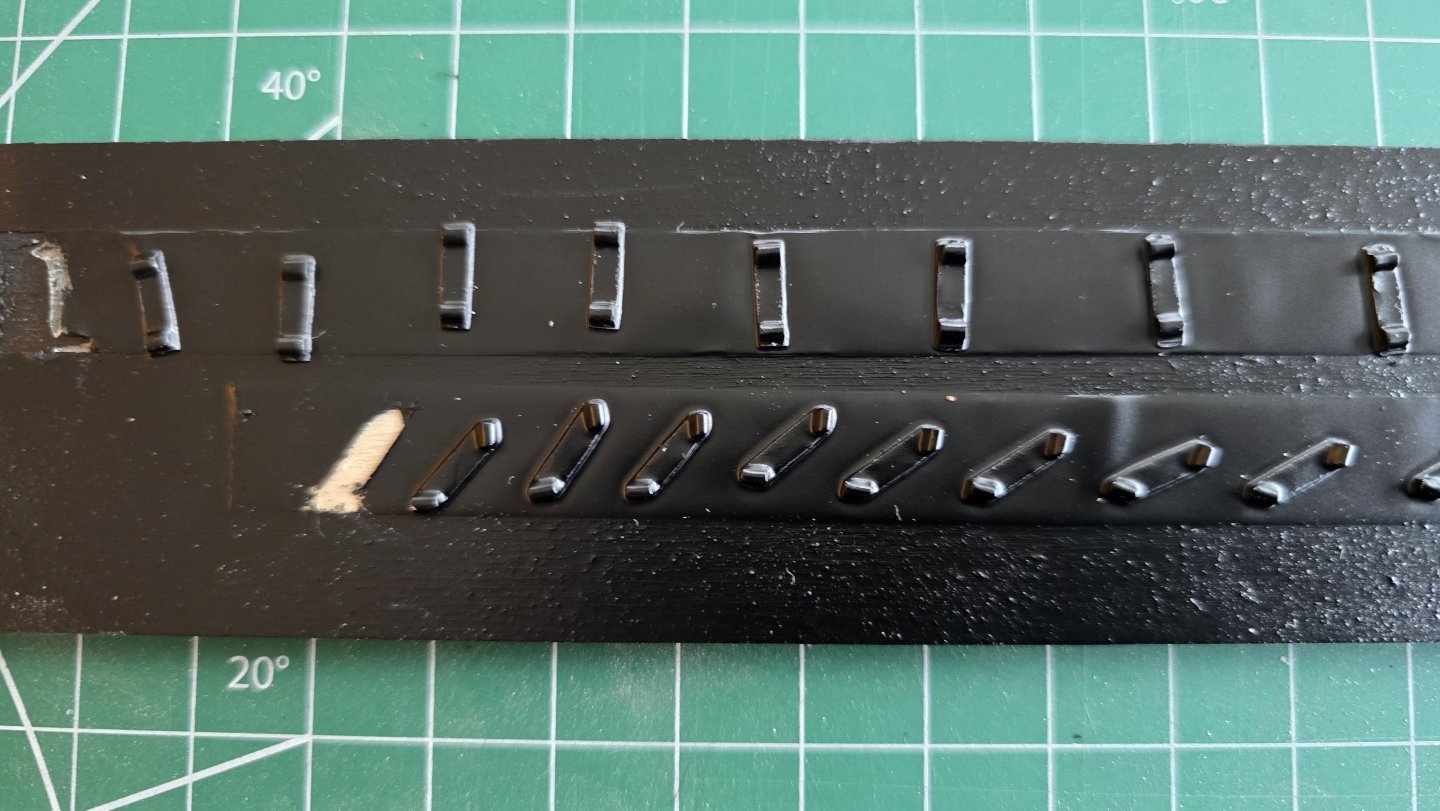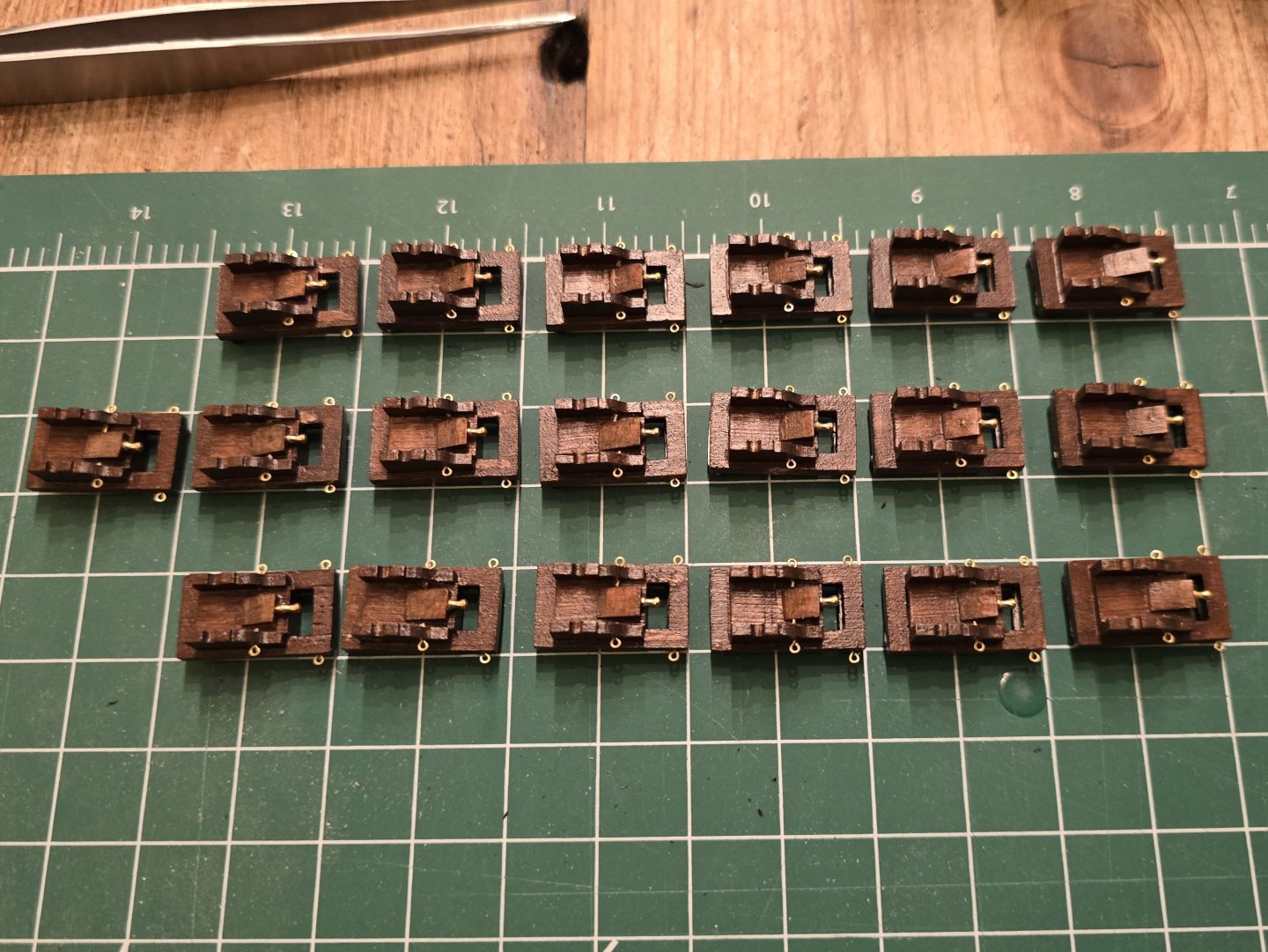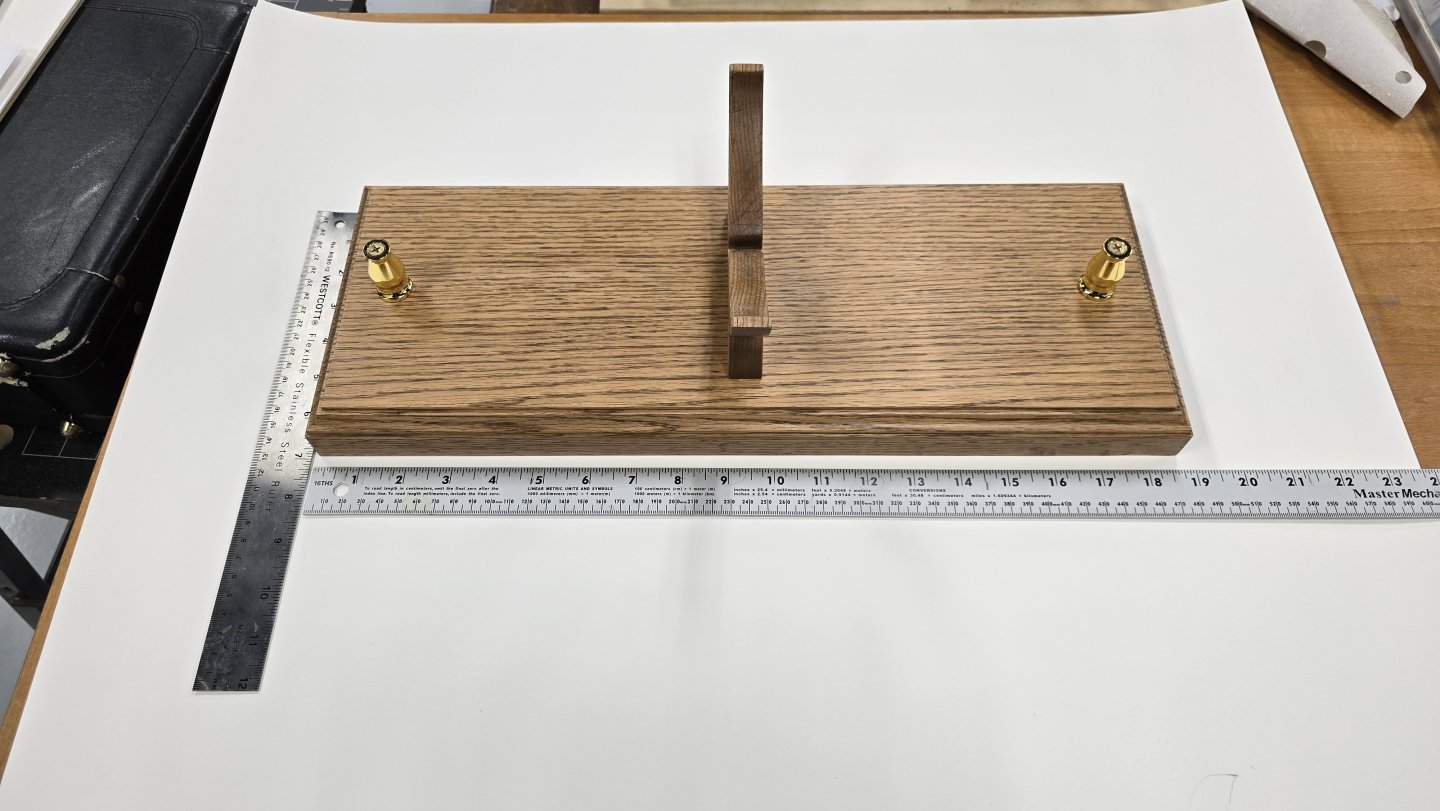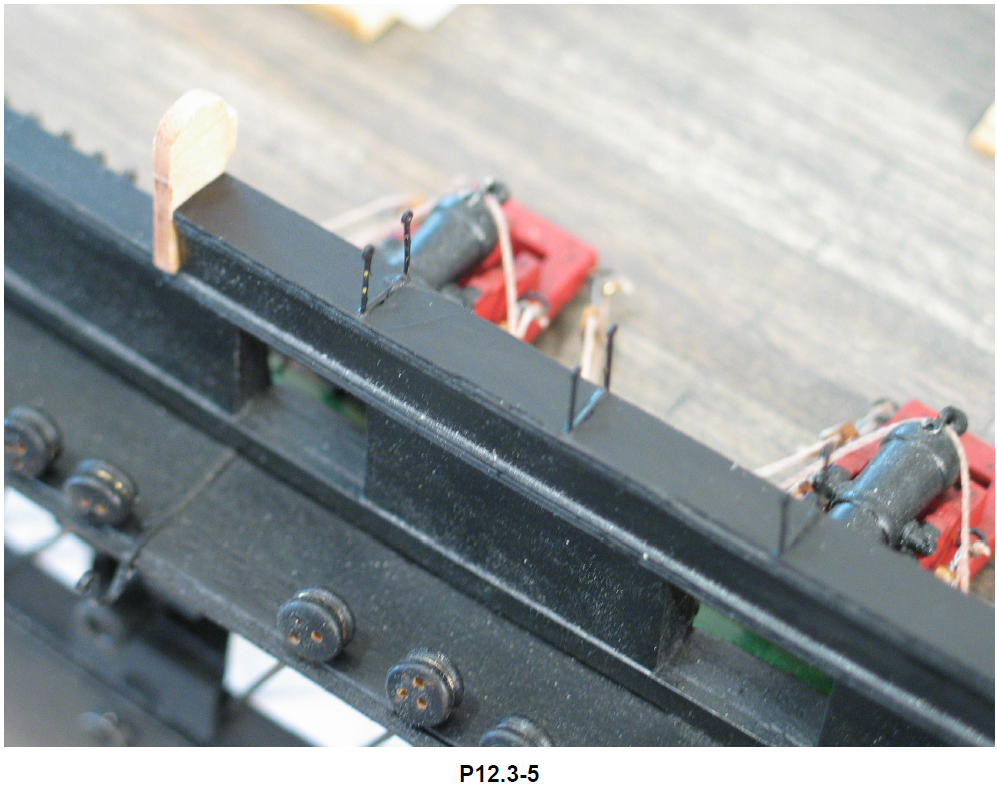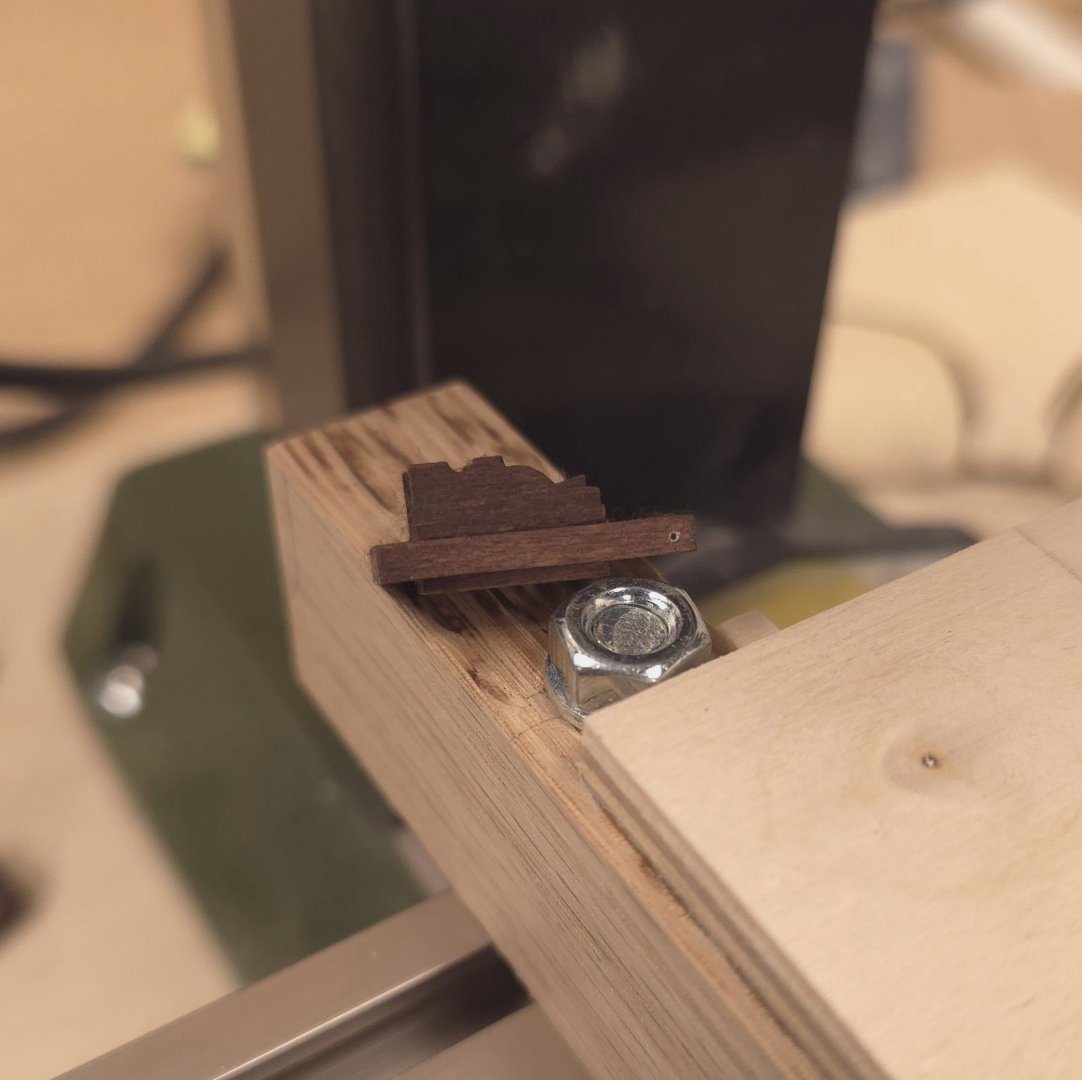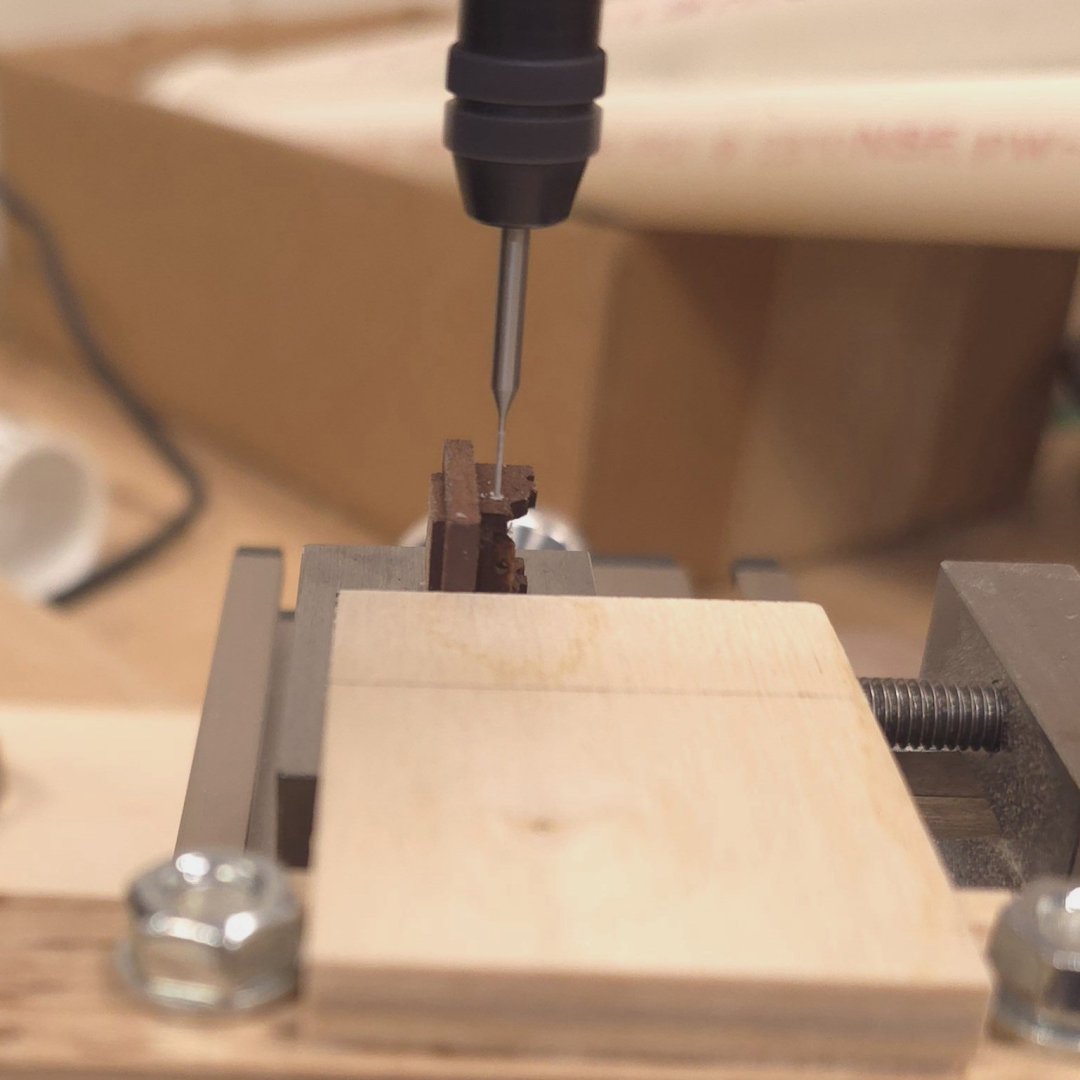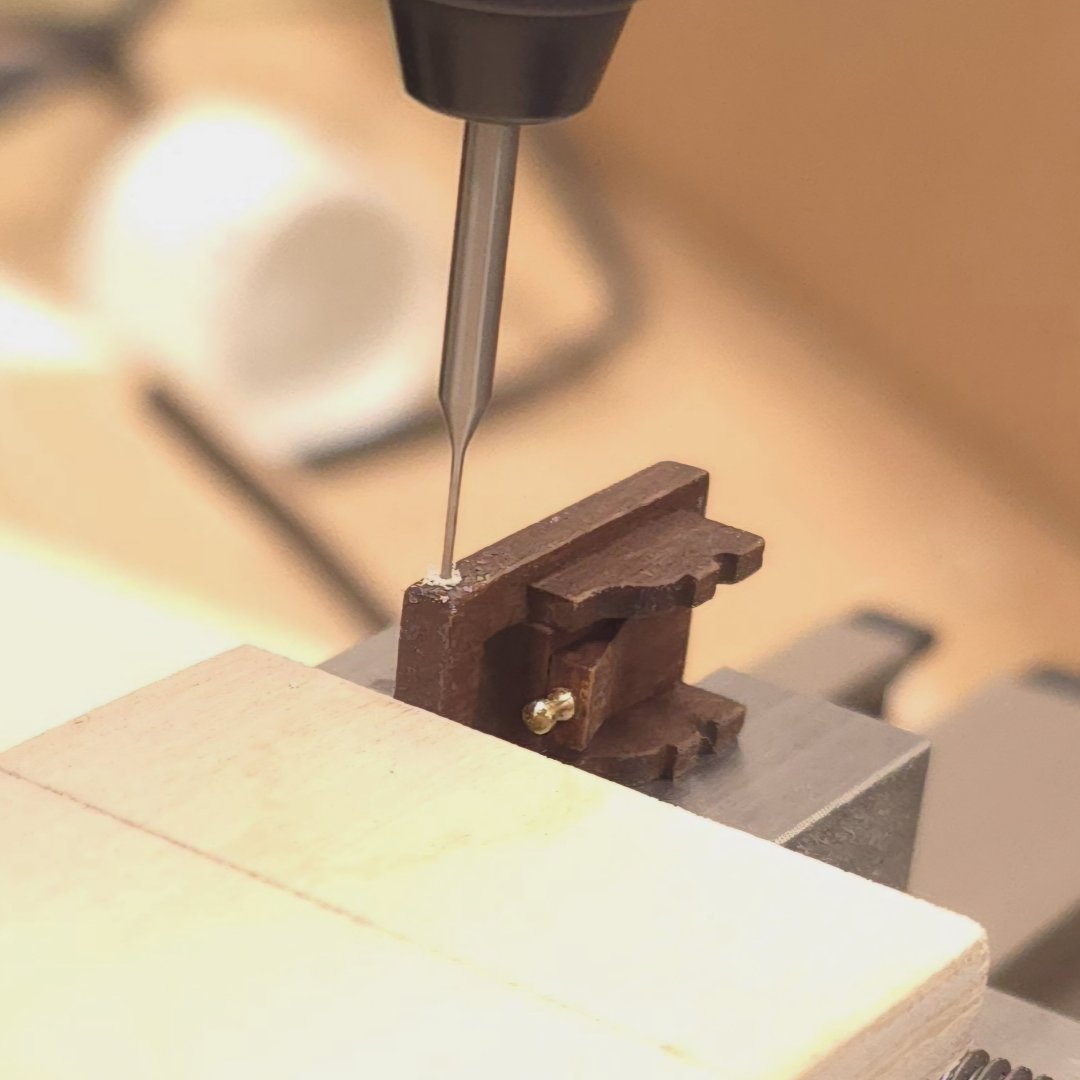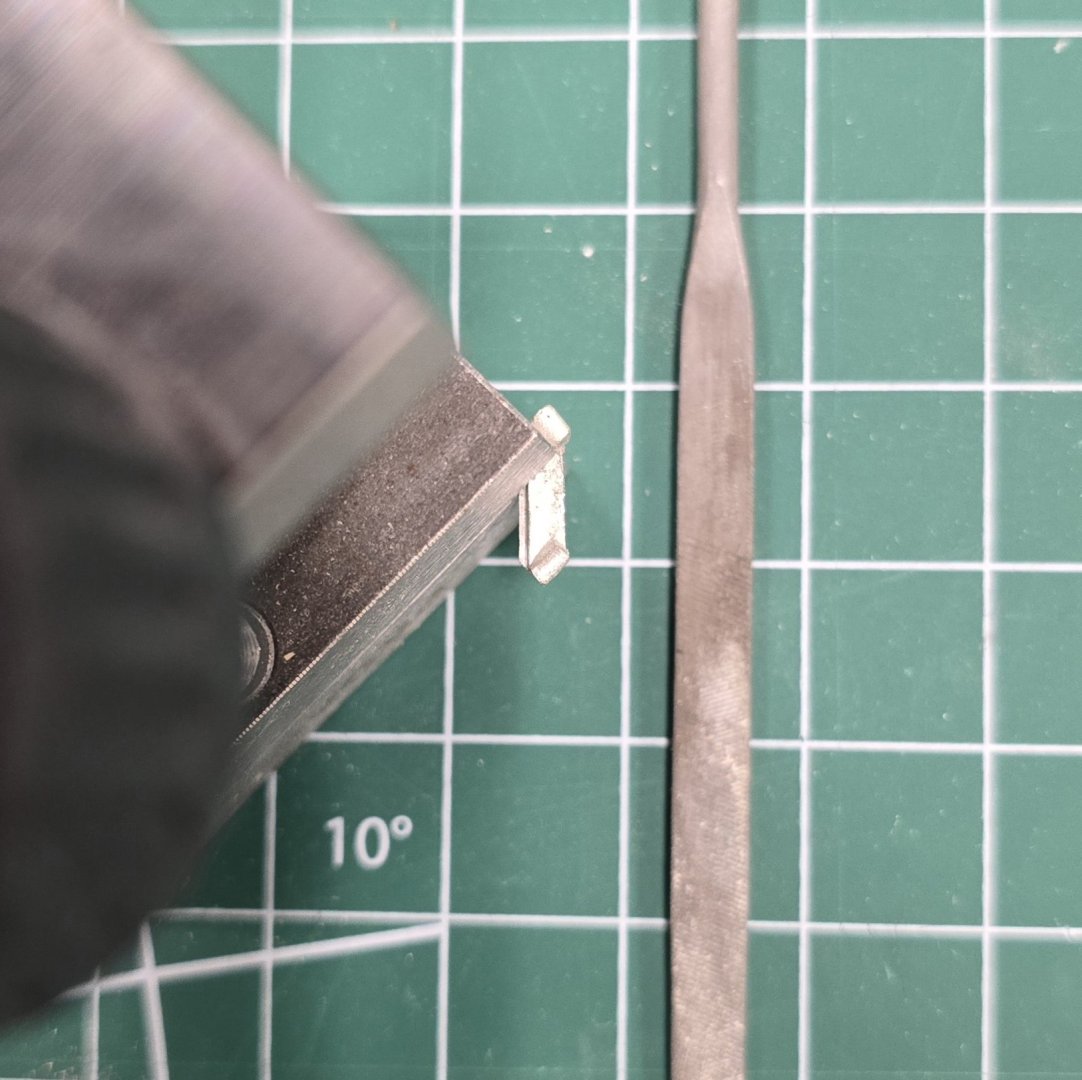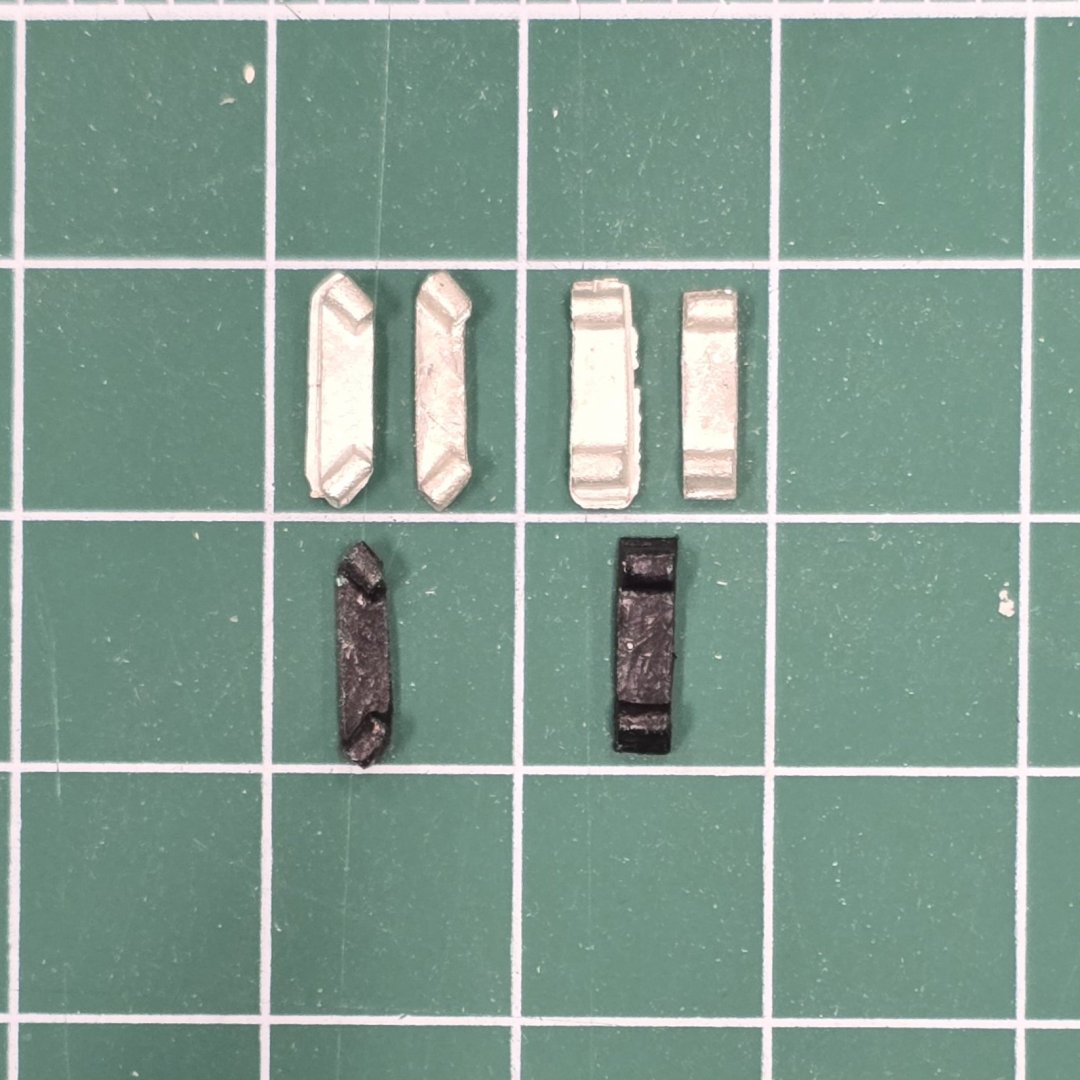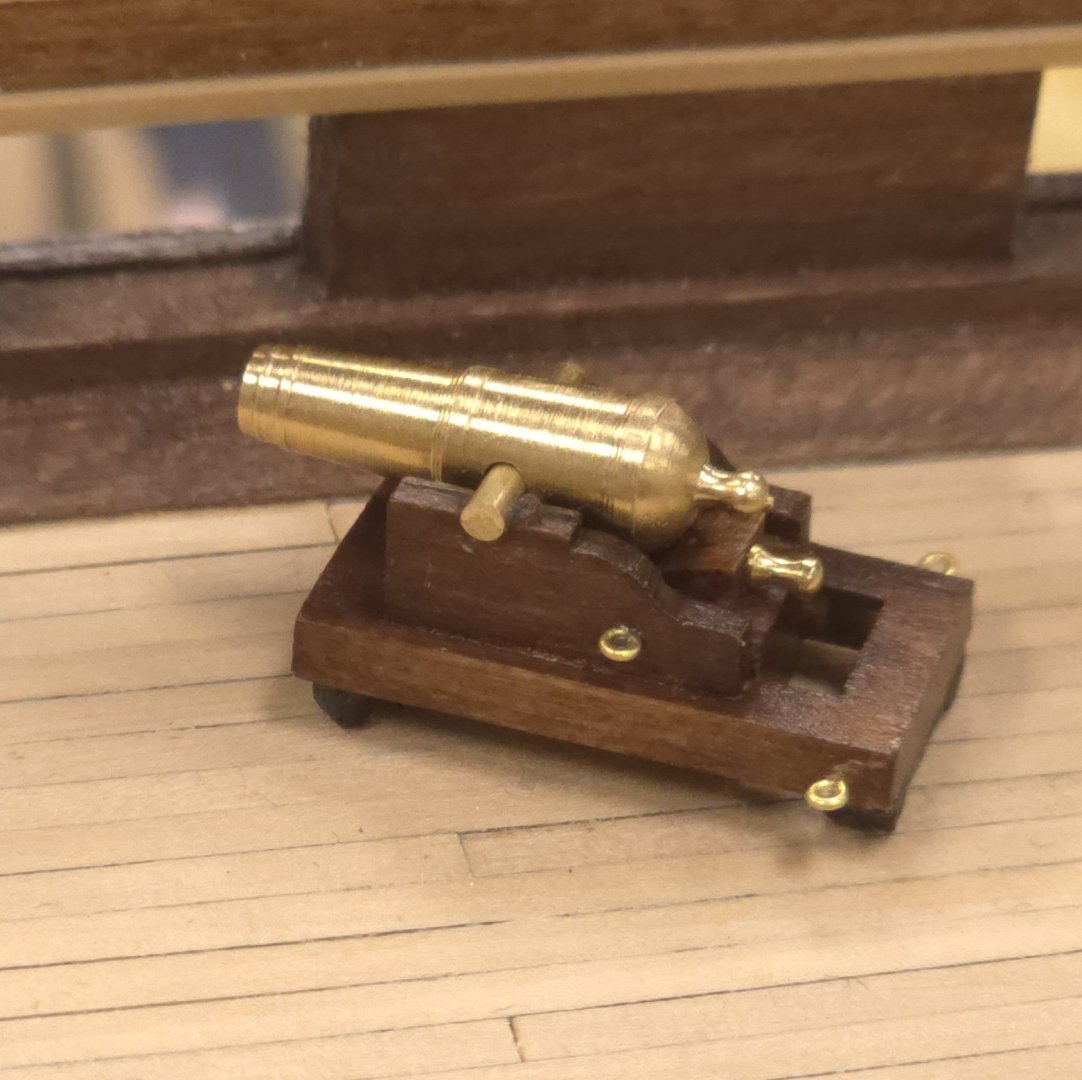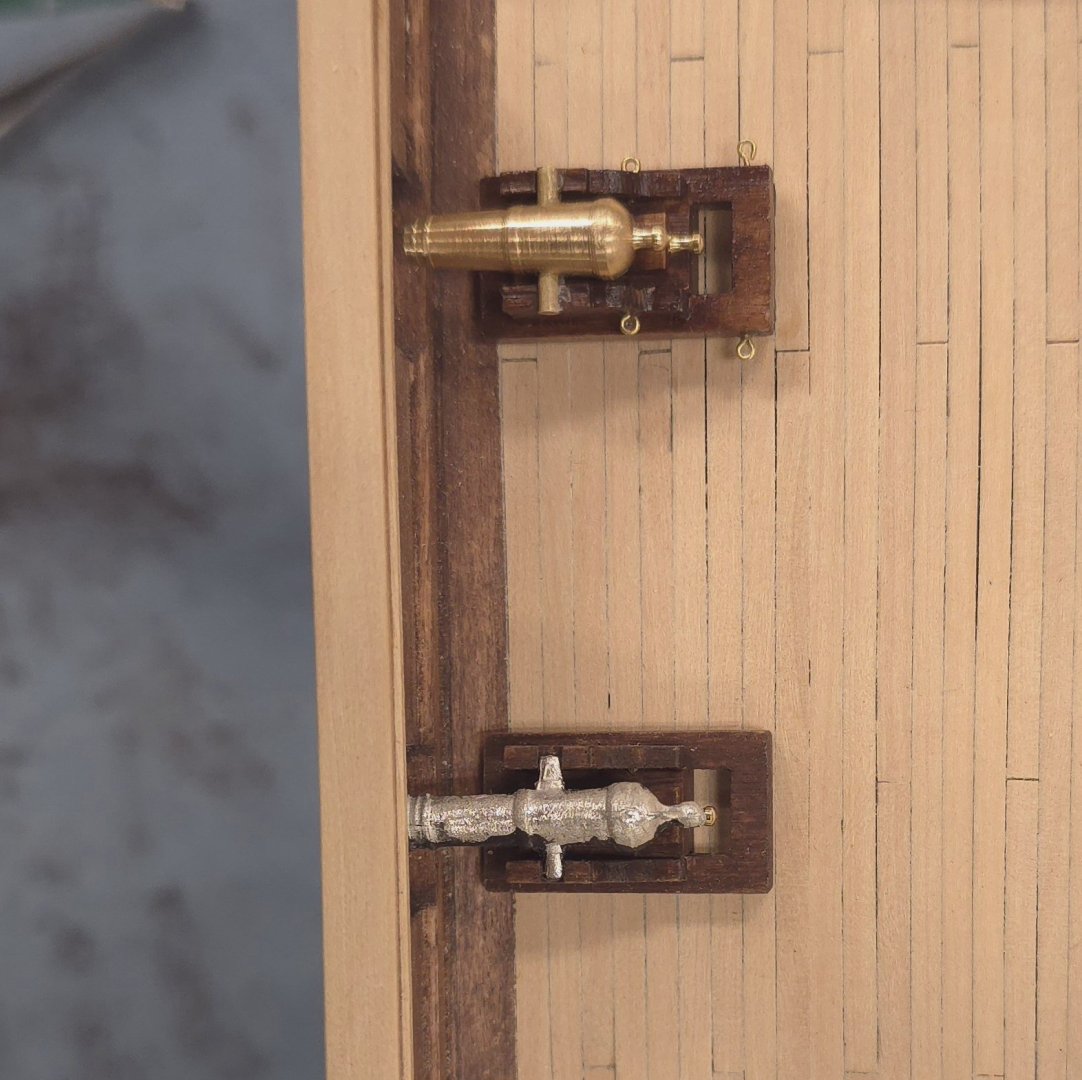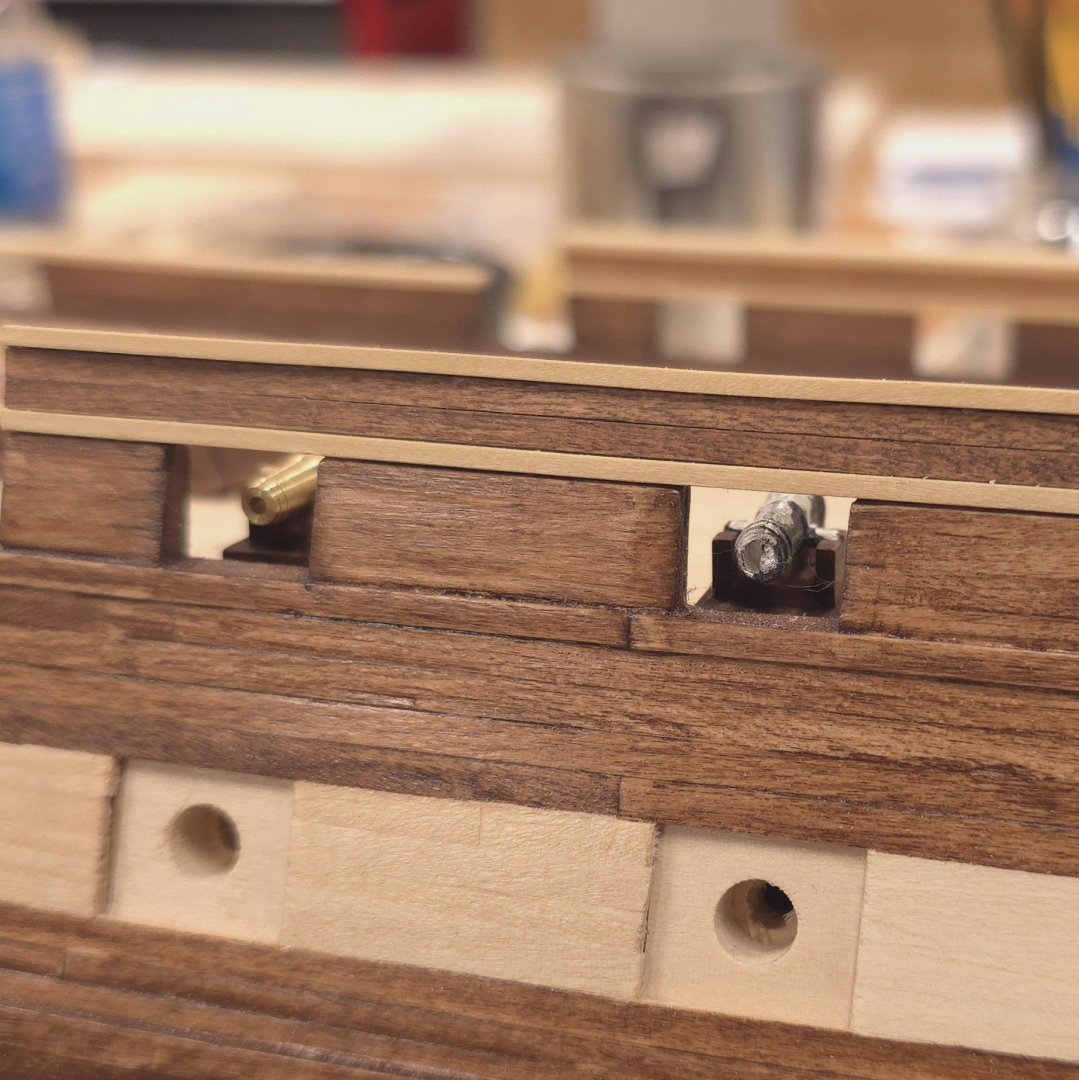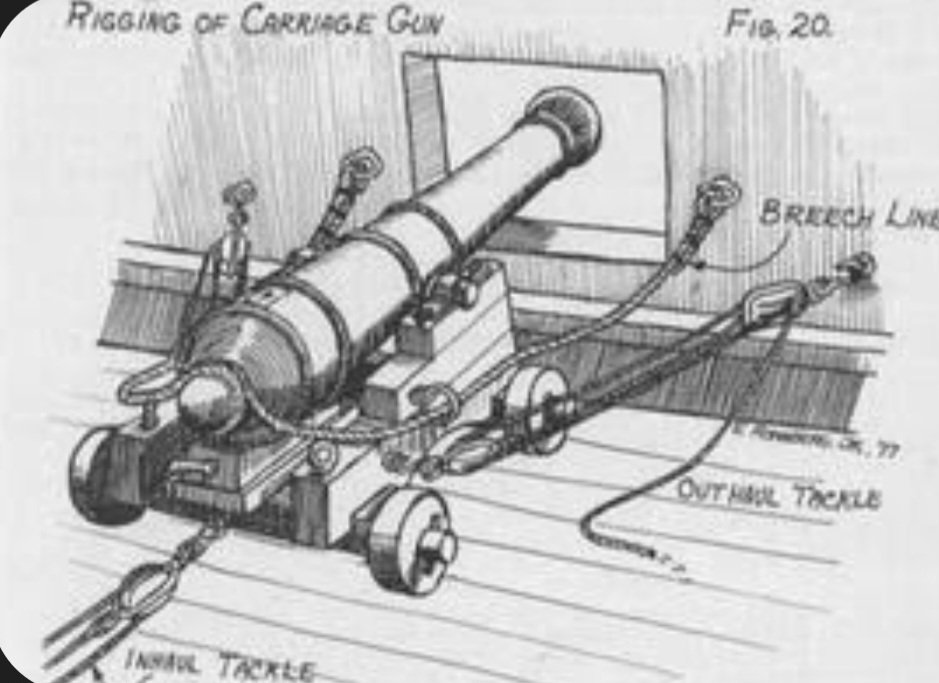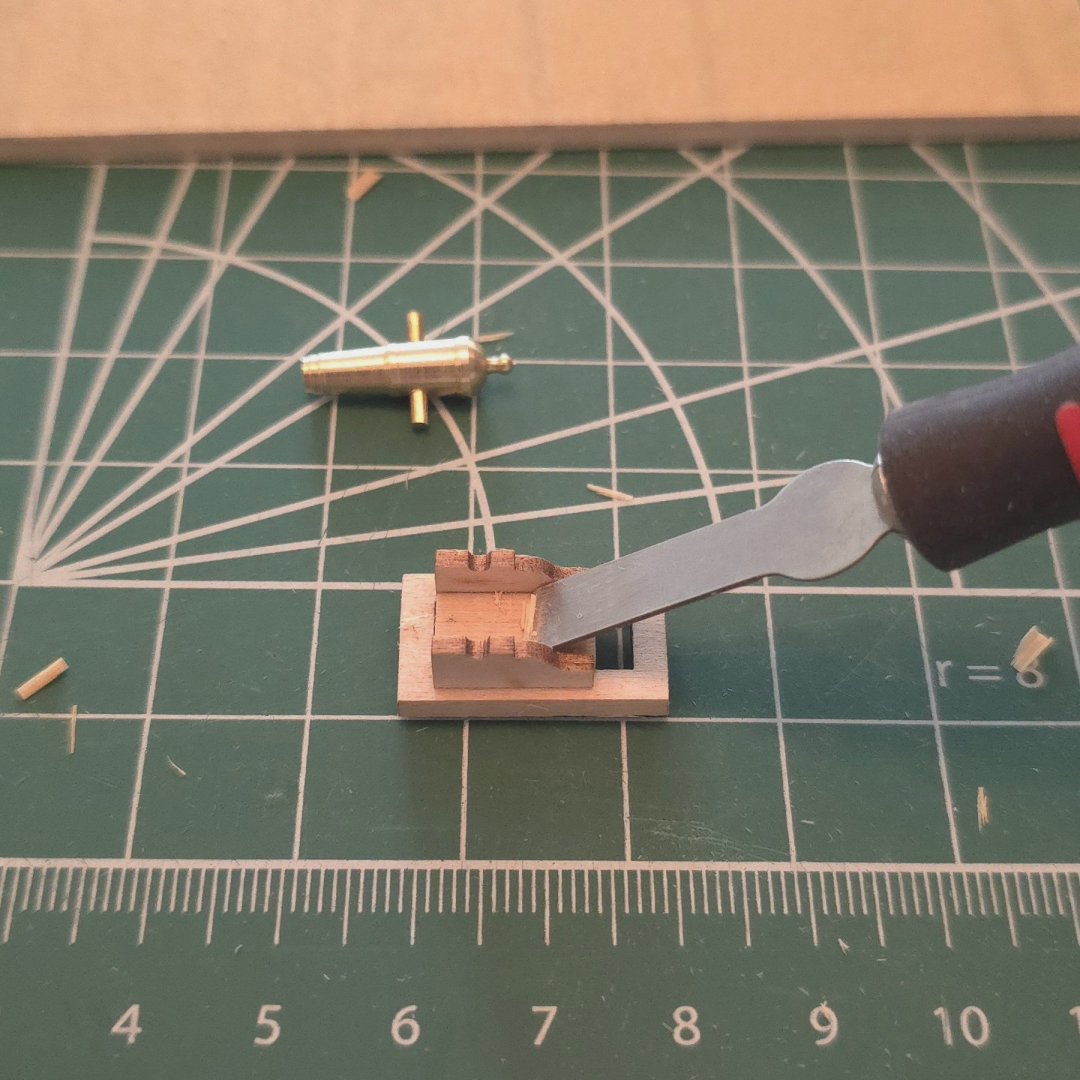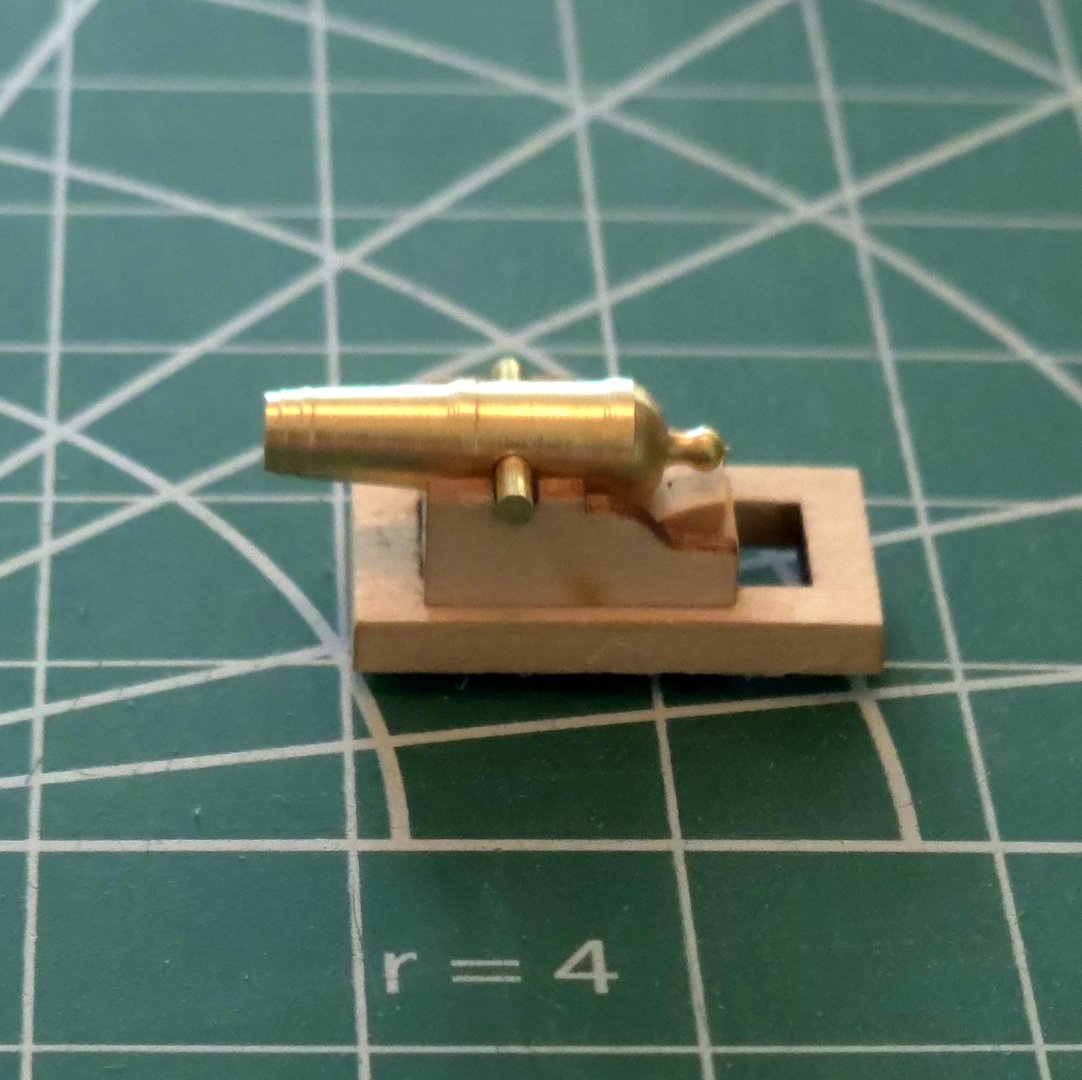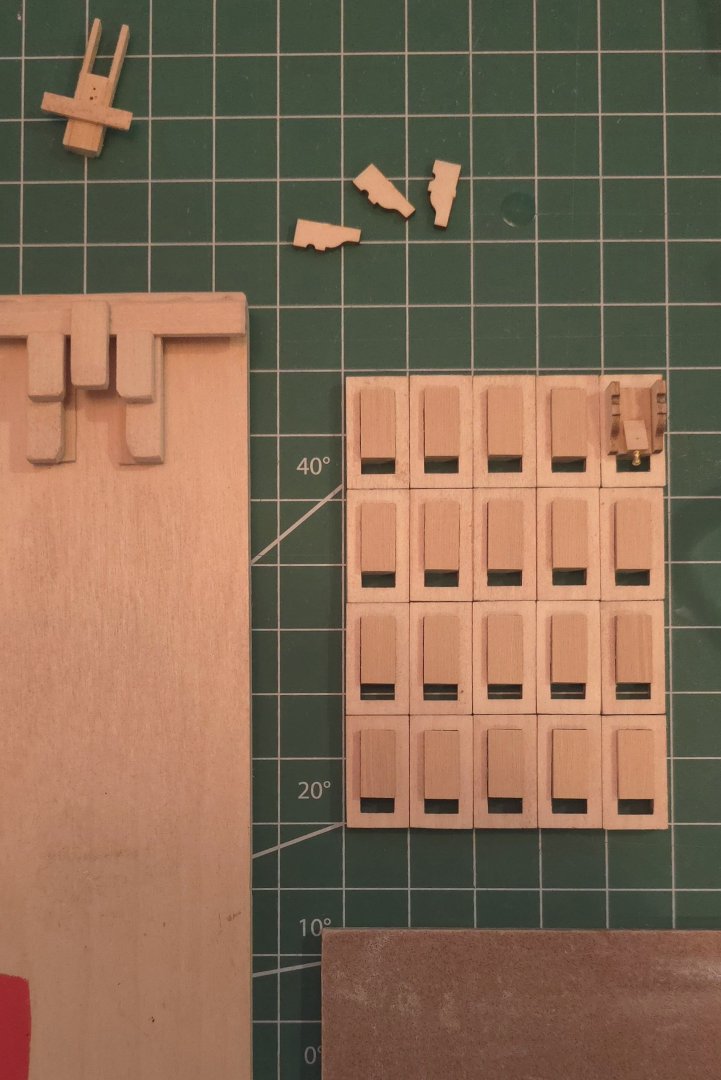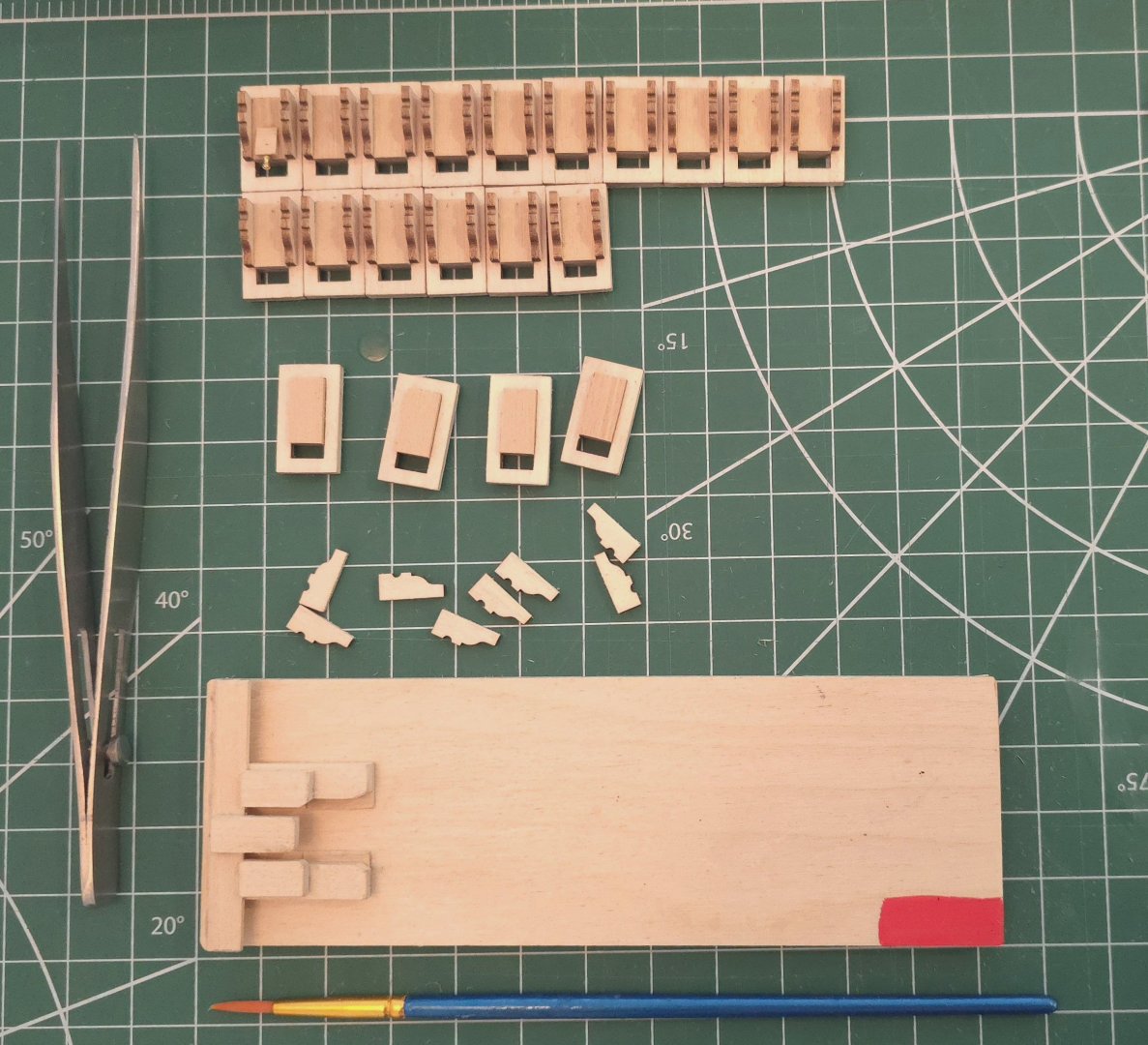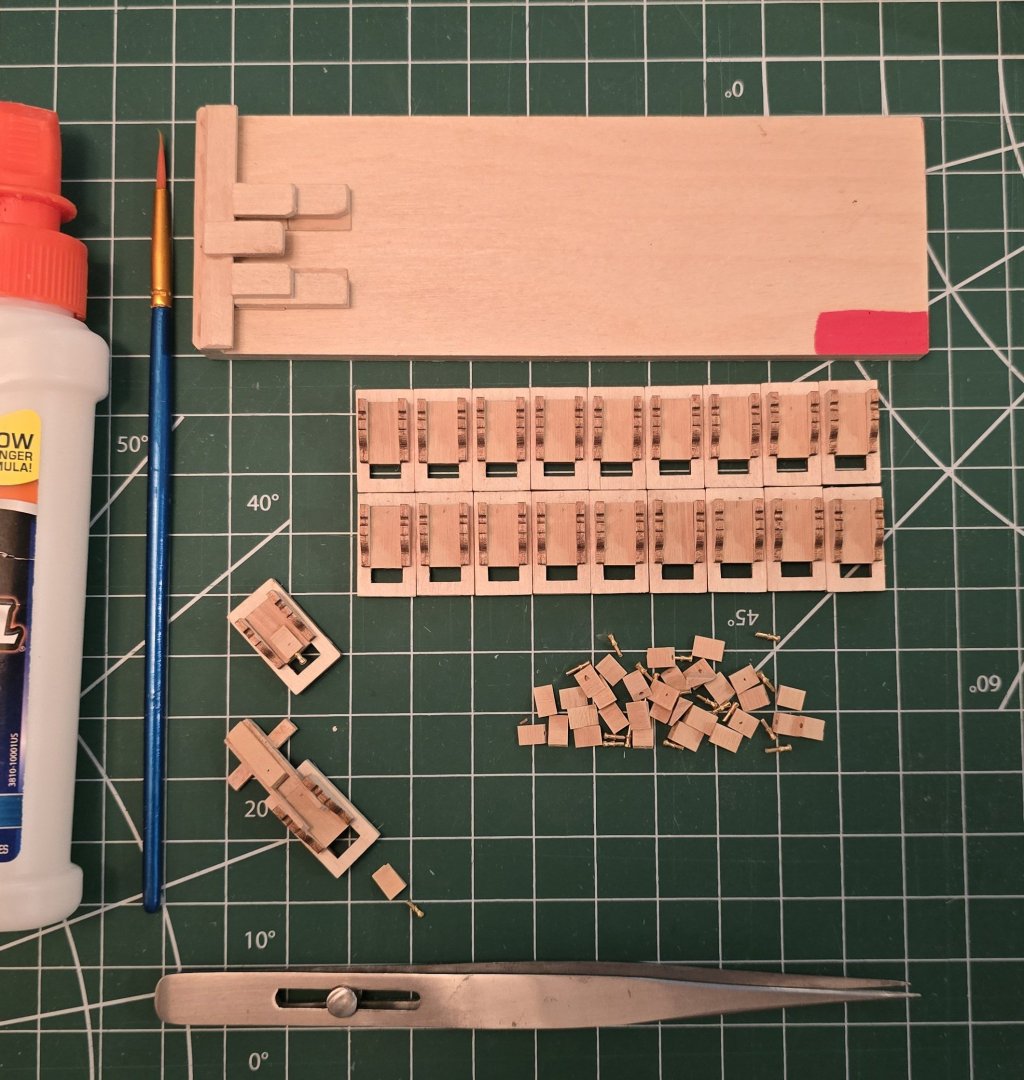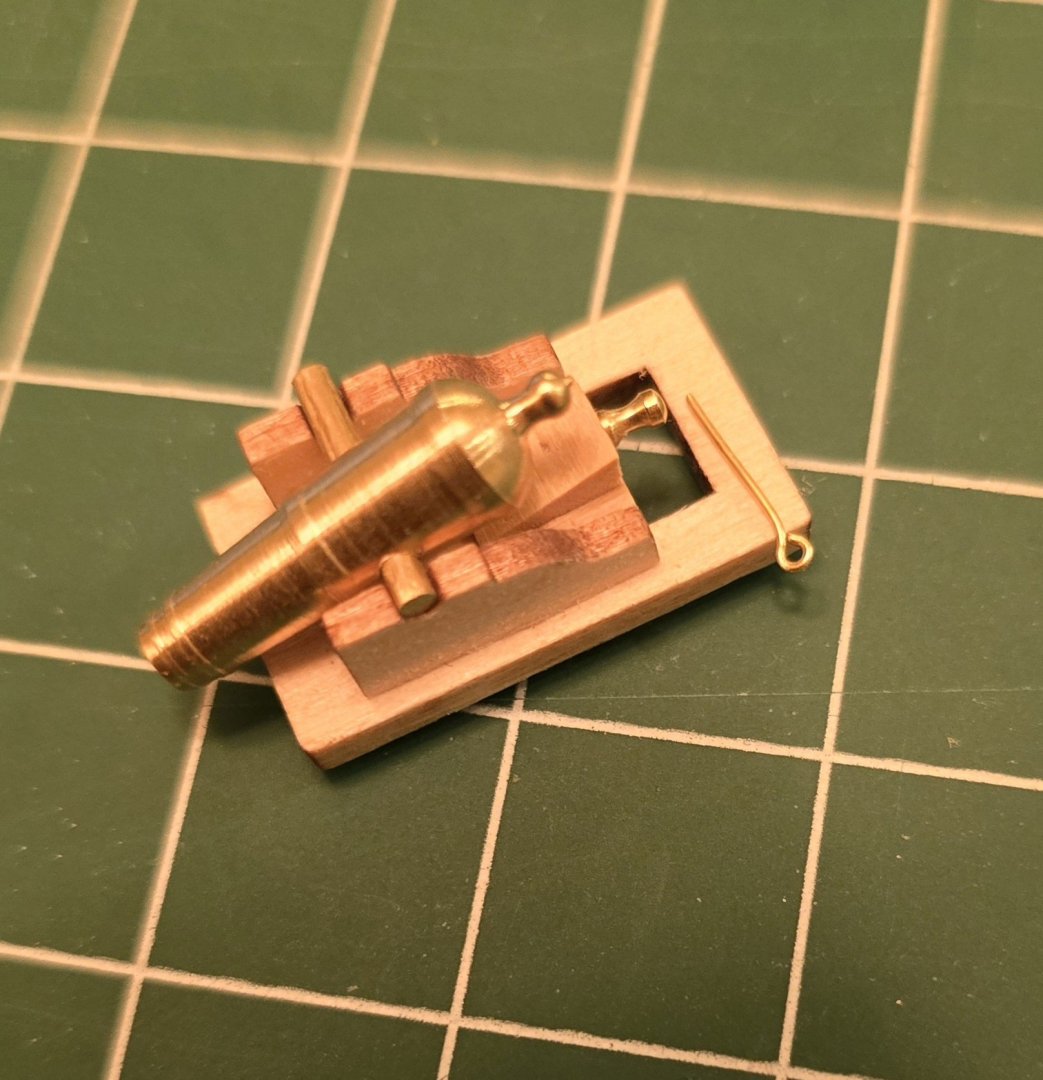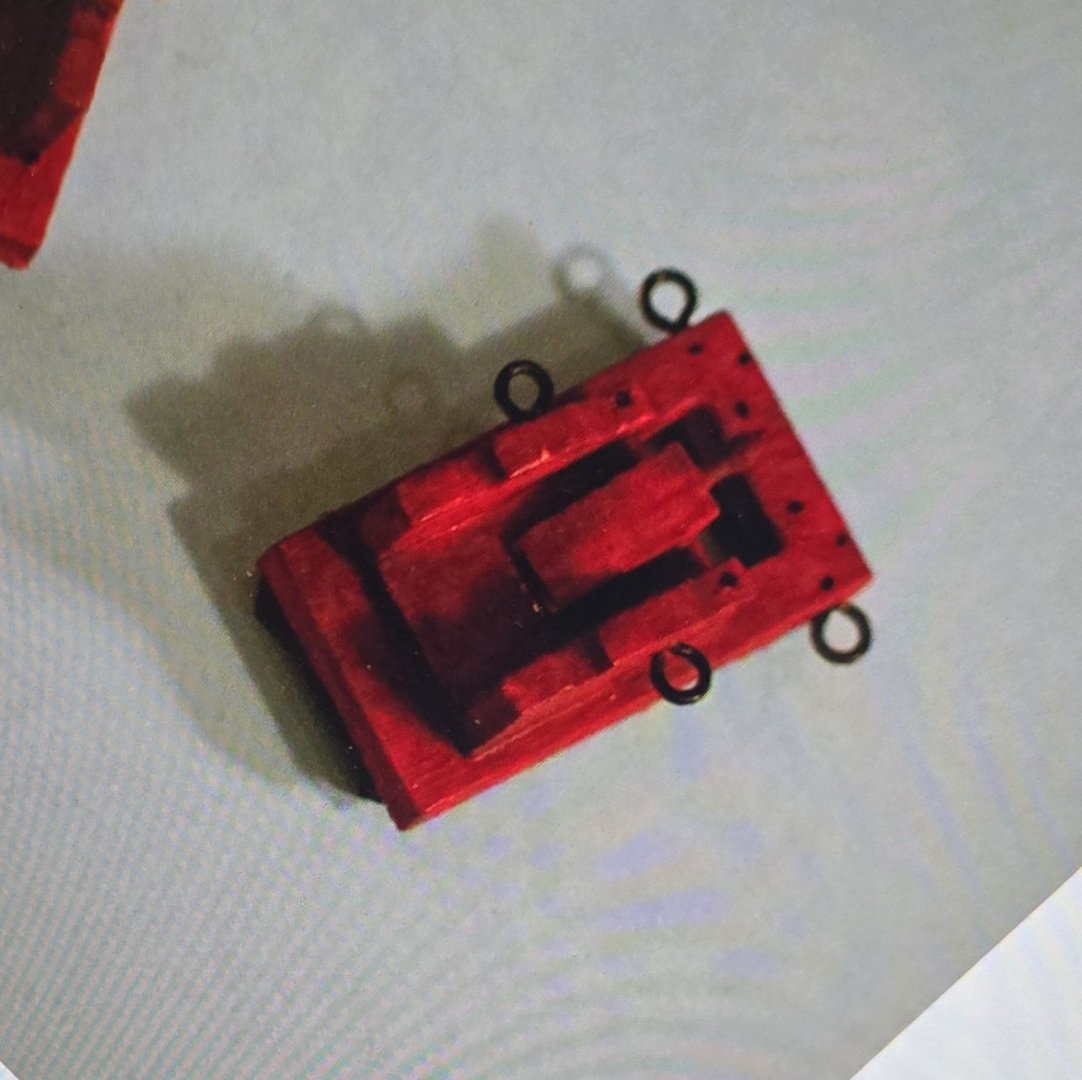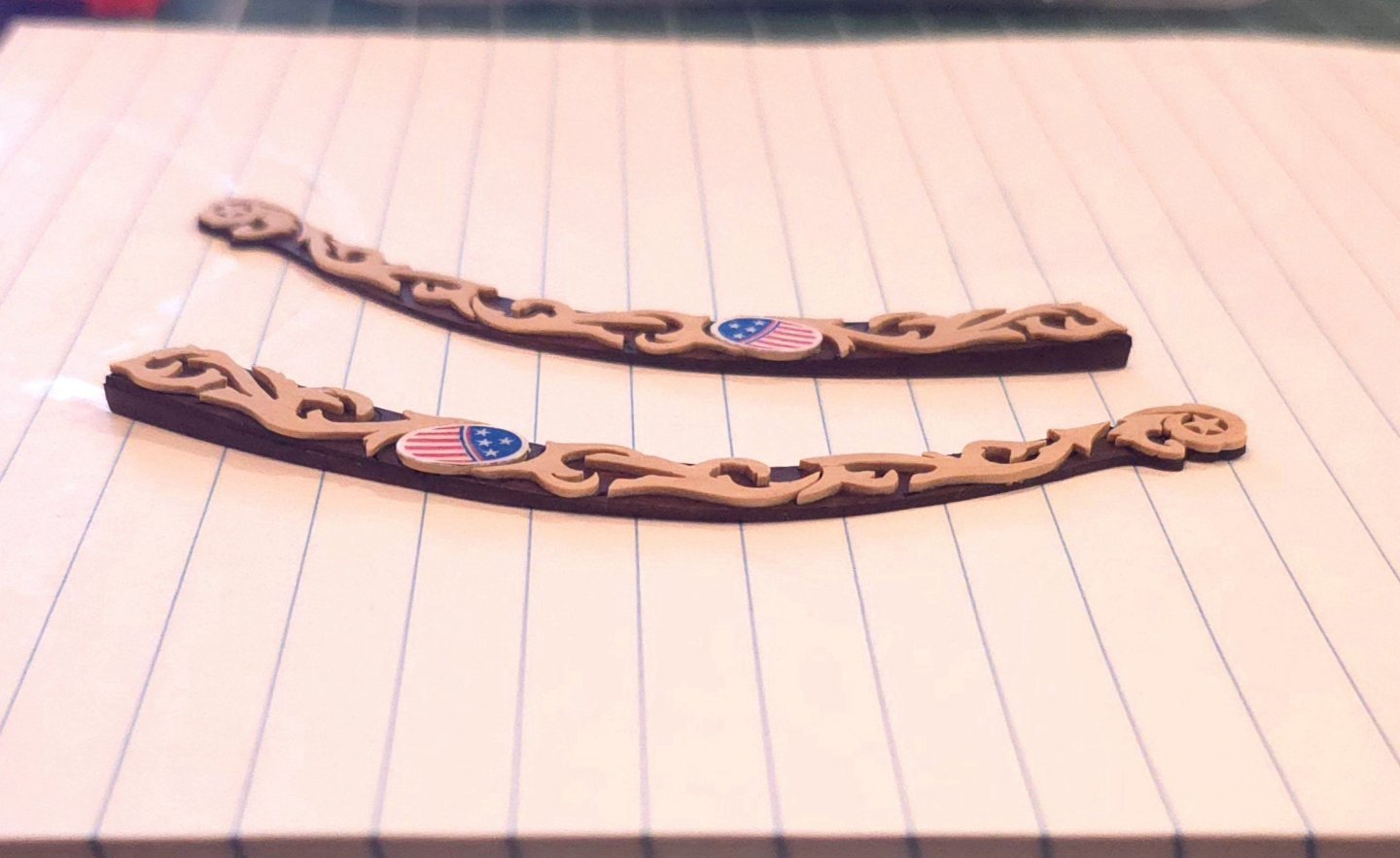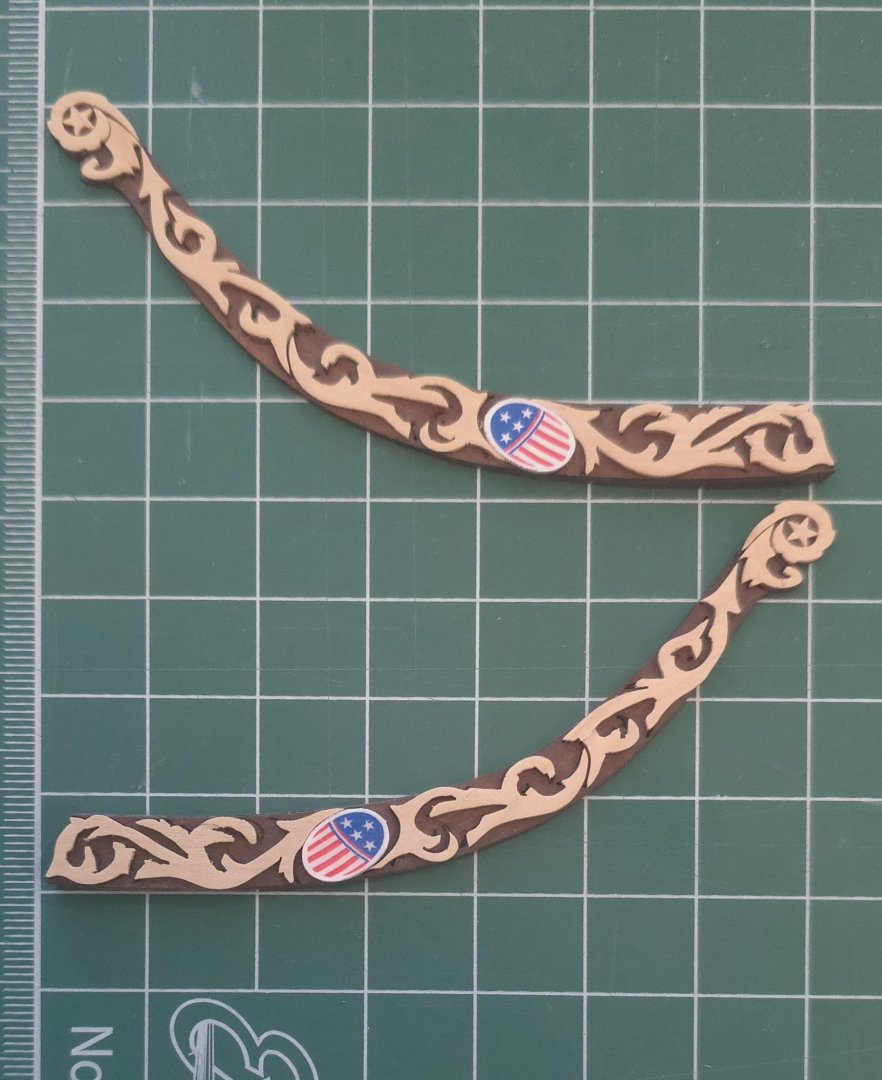-
Posts
982 -
Joined
-
Last visited
Content Type
Profiles
Forums
Gallery
Events
Everything posted by Der Alte Rentner
-

USS Constitution by mtbediz - 1:76
Der Alte Rentner replied to mtbediz's topic in - Build logs for subjects built 1751 - 1800
-
Decision made. I'm sticking with the status quo. I made more work for myself by applying 2 coats of clear polyurethane to the carriages before adding the eyebolts and pins on the quions. The poly clogged the holes, which then had to be bored out by hand. I didn't like hand painting the wheels, so used double sided tape and spray paint/primer instead.
-
By trestle, I assume you mean the display base that I made for the Constitution. If so it's roughly 18 1/2" wide, 7" deep and 1 1/2" tall. As for the central support, I use the billet from which the bulkheads were pulled to get the shape. The height of the pedestals and the measurement from the base to the bottom of the groove in the central support are 1 3/8".
-
No, I very carefully painted on wood glue for all of the assembly on the carriages. I wanted to have a little bit more work time, and I didn't want to risk anything sticking permanently to the fixture. I am not going to take those carriages apart. I just arrived at the shipyard and I'm going to spend a couple of hours scratching my head over the matter and see where it goes from there. Thank you, Mustafa.
-
Don't sweat it Jon, I'm a long way from getting to that. I only jumped ahead to the carronades because I needed something small that I could pack up and take with to work on during my absence from the shipyard. I'll finish those and then return to the hull for the time being. If you do find that source for the printed versions, great. If not, I'll cross that bridge when I come to it. Who knows, if I put on my metal workers hat and tackle plan C (see my most recent post) and do so successfully, I might consider following in your footstep on these canopies.
-
Thank you Gregg, Bob and Mustafa. I had the exact same thoughts as Gregg and Bob this morning, and reached much the same conclusion as Mustafa. It's too late to move the upper part of the carriage. However, Since I haven't yet glued the front wheel pieces to the remaining 19 carriages, I could simply glue these further back under the carriage to get a smidge closer to the ports. Not enough to really matter, I think - and if one looked carefully, one would question why the they were placed there. Were I to do that, I may as well ditch the wheels altogether and glue a small rectangle to the bottom of the carriages in lieu of the wheels - saving time and effort in shaping those infernal cast parts - period! I'll experiment with that to see If I can get away with it. Another thought was to try to trim/carve the waterways back without destroying them or the planking butting up against them. (Danger, Danger, Will Robinson!) 🤔 No, I'm don't think I'm going to attempt that. Plan C - Maybe I can attempt to make some extension out of brass and affix them to the business end of the carronades? I think matching the color and "finish" of the rest of the carronade will be problematic. Plan D - Replace all the carronades with long gun barrels? Costly, and I'm sure I'll get an earful from the historical purists out there. Or I can go the way of Bob Hunt himself. Ignore it.. I took a much closer look at Chapter 11, page 42, of the practicum and realize that Bob himself attempted to conceal the issue in the way he photographed the carronades. Of course, he used the crappy materials from the kit, which did afford him the luxury of a couple extra millimeters, but even his carronades fall short of poking through the gunports. Here's a photo from Chapter 12 that I think clearly illustrates that Bob fell short, and didn't care(?). After I submit this post, I'm going back into the early pages of this build log and issue a caveat to others about the error in the Practicum that led to this dilemma. I knew then the waterways were not according to plan, but I didn't realize how big a difference it made until now.
-
Oh snap! Thanks to a mistake I acknowledged way back when when installing the waterways, my carronades do not fit well on the spa deck. The waterways are way too big and I can't get the carronade anywhere close enough to the gun ports to look good. Hell's bells, not even the longer parts that came with the kit will reach the gun ports. Sigh.. See last two photo in this set to see what I'm talking about.
-
Wow! talk about a labor intensive process.. In the end, it all comes down to the results. And yours are spectacular.
- 233 replies
-
- Model Shipways
- constitution
-
(and 5 more)
Tagged with:
-

USS Constitution by mtbediz - 1:76
Der Alte Rentner replied to mtbediz's topic in - Build logs for subjects built 1751 - 1800
Once again Mustafa, beautiful work! I can hardly wait to see how you rig the long guns, given that the long guns do not have that ring at the cascable. I just decided to jettison the MS kit carronades and go with the set I got from Czechoslovakia. So, my plan will be to steal your rigging Technique. 😁 -
Some whittling was required to get the carronades to sit level in the carriages. The longer guns from the MS kit would not have required this modification, but I think my direction is decided. I'm going to stick with the brass carronades, and stain the carriages the same color as the hull planking. I just couldn't see going with black carronades and red carriages everyone is using on their MS builds. It's just not in keeping with the character of my vision for mine. Drat! The stain I purchased here isn't the same color or consistency as the gel stain I used on the hull. It was the only thing I could find at the local Ace Hardware, so, next steps will have to wait until I return to the shipyard next week. Oh well...
-
Thank you Gregg and Jon, Sadly, one tool I forgot to bring with me was my Vernier caliper. Measurements will have to wait. So, carronades will be a back burner issue until I return to the shipyard. In the mean time, I will likely go ahead and build the carriages. Keeping Mustafa's caveat in mind, I've convinced myself that I won't have a problem drilling holes for the eyebolts after the carriages are assembled. I tried hand drilling one today. That's not going to fly! I'm pretty sure I can setup the Proxxon mill to handle the holes later. All I need to do is construct another fixture or two. (famous last words?)🤔 I did bring one of the kit's carronades with me. Judging from the plans you two provided, I think these are too long. However, after doing some cleanup and painting it black, I might yet opt to use the MS parts. The rigging issue will thus be taken care of. Off to the pool.. Enjoy the winter up North!
-
Is it just me? Or are the eye bolts that came with my kit a lot smaller than they should be. Compare and contrast to a picture from the Hunt practicum. Also, because the diecast carronades that came with the kit are in such horrible shape, I purchased some replacements online. (Scroll back a few posts if you don't remember this..) These do not have the eye bolts attached at the cascabel that appears on the ones in the model shipways kit. Hipexec discussed this in his build somewhere on page 31. I can't say I like any of the three solutions broached in that discussion. I really don't want to have to file every single one of the model ship ways carronades, (which I didn't bring with me anyway). But I can't see me attempting to drill holes in the cascabels and inserting eye bolts to facilitate rigging. Sigh..
-

USS Constitution by mtbediz - 1:76
Der Alte Rentner replied to mtbediz's topic in - Build logs for subjects built 1751 - 1800
in the ultra close up, the workmanship is even more impressive. wow! -

USS Constitution by mtbediz - 1:76
Der Alte Rentner replied to mtbediz's topic in - Build logs for subjects built 1751 - 1800
inspiring work, as always. I'd love to see some photos of the technique you use in rigging the carronades. I assume you do the seizing (right term?) before you glue the eyebolts in. -
Thank you Jon, Here's the view from the side showing the wedges. They are there to pair with the hawse ports, that will be added later. While the ports are cut directly into the hull in the Hunt practicum, I've learned that there is some structure added to the hull between the cheek knees. I'm following several builders in adding that feature.
-
I searched the MSW site and found your initial dialog with Helmarsowick in 2023. I believe his supplier is located in Poland, which suggests the ordering process may be a bit of an issue. I wonder if anyone in the USA offers this product. But, if you do get the details on ordering the printed canopies, I'd likely follow suit and order them too. Thanks Jon
About us
Modelshipworld - Advancing Ship Modeling through Research
SSL Secured
Your security is important for us so this Website is SSL-Secured
NRG Mailing Address
Nautical Research Guild
237 South Lincoln Street
Westmont IL, 60559-1917
Model Ship World ® and the MSW logo are Registered Trademarks, and belong to the Nautical Research Guild (United States Patent and Trademark Office: No. 6,929,264 & No. 6,929,274, registered Dec. 20, 2022)
Helpful Links
About the NRG
If you enjoy building ship models that are historically accurate as well as beautiful, then The Nautical Research Guild (NRG) is just right for you.
The Guild is a non-profit educational organization whose mission is to “Advance Ship Modeling Through Research”. We provide support to our members in their efforts to raise the quality of their model ships.
The Nautical Research Guild has published our world-renowned quarterly magazine, The Nautical Research Journal, since 1955. The pages of the Journal are full of articles by accomplished ship modelers who show you how they create those exquisite details on their models, and by maritime historians who show you the correct details to build. The Journal is available in both print and digital editions. Go to the NRG web site (www.thenrg.org) to download a complimentary digital copy of the Journal. The NRG also publishes plan sets, books and compilations of back issues of the Journal and the former Ships in Scale and Model Ship Builder magazines.

